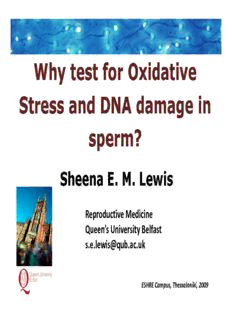
Why test for oxidative stress and DNA (damage) PDF
Preview Why test for oxidative stress and DNA (damage)
WWhhyy tteesstt ffoorr OOxxiiddaattiivvee SSttrreessss aanndd DDNNAA ddaammaaggee iinn ssppeerrmm?? SShheeeennaa EE.. MM.. LLeewwiiss Reproductive Medicine Queen’s University Belfast [email protected] ESHRE Campus, Thessaloniki, 2009 Semen analysis • Essential for initial diagnosis • Limited as prognostic tool for ART • Only 20% of young Norwegian men achieve WHO values Jorgensen et al, 2006 • Only 46% of older men >45yrs (n=1174) meet all WHO values Hellstrom et al, 2006 • In infertility diagnosis- Many men with ‘below normal’ values can be fertile Haugen et al, 2006 • Men with ‘normal’ values can be infertile Bonde et al, Lancet 1998 Clinical significance of semen profiles No single parameter was diagnostic of infertility (n=1461) Extensive overlap between fertile and infertile ranges Morphology most powerful Guzick et al, 2001 Morphology most powerful but volume and motility of limited value Probability of pregnancy ↑↑↑↑ as concentration ↑↑↑↑ up to 40 x 106 /mL tthheenn nnoo ffuurrtthheerr aassssoocciiaattiioonn ((nn==443300)) extensive overlap between fertile and infertile ranges Bonde, Skakkebaek et al, 1998 Concentration and motility were most powerful Morphology poorest predictive power - 50% of fertile men had abnormal morphology (n=719) Nallella, Agarwal et al, 2006 243 fertile men had a mean of only 20% normal morphology by WHO 1992 criteria Chia et al, 1998 Regional and world- wide variation of semen parameters • Within USA, New York had highest concentrations (134 x 106/mL) Iowa had lowest concentrations (48 x 106/mL) Thailand (52 x 106 /mL) • In Japan, fertile men had lower semen quality, similar to Norway (20% < WHO) • In Europe, Finland and Denmark’s fertile men have markedly different semen profiles Fisch et al, 1996, Swan, 2006; Jorgensen et al, 2006; Iwamoto et al, 2006 Variability of semen parameters between and within individuals • Marked biological heterogeneity of semen between 243 fertile men Chia et al, 1998 • Even consecutive samples from same individuals (twice a week for 120 weeks) WHO, 1990 (673 samples from 7 men over 324 weeks) Mallidis et al,1991 Reference values have limited diagnostic value for infertility and are not predictive for ART Intracytoplasmic sperm injection ISCI- 1992 Success for men with poor semen quality Only requirement is sperm viability Natural barriers removed (poor motility or defective sperm zona binding) UUssaabbllee wwiitthh iimmmmaattuurree ssppeerrmm Pregnancy rates of 30-50% The ‘ISCI Escalation’- almost twice as many cycles as IVF -reduction in andrological research ESHRE’s European IVF Monitoring Consortium, 2008 Sperm DNA damage Male Infertility Occupation Plastics and resins, solvents, wood processing, metal industry, AAuuttoommoobbiillee,, ttrruucckk aanndd aaiirrccrraafftt mmeecchhaanniiccss Sedentary or stressful job Environment Lifestyle Endocrine disruptors diet xenoestrogens smoking Genetic Inheritance Anti-androgens alcohol CABVD recreational drugs Toxic compounds Robertsonian STDs translocations injury Y-chromosome deletions infection Paternal Age High levels of sperm DNA damage have some correlation with • Oligozoospermia Irvine et al, 2000, Shayegon and Zini, 2002, Menezo et al, 2003, Schmid et al, 2003, O’Connell et al, 2003 • Poor motility and morphology OO’’CCoonnnneellll eett aall,, 22000033,, SSaalleehh eett aall,, 22000033 • OAT Gandini et al, 2000; Siddighi et al, 2004; Trisini et al, 2004; Huang et al, 2005, Appasamy et al, 2007 • Cytoplasmic retention Huszar et al, 2001, Aitken et al, 2006 • mtDNA damage O’Connell et al, 2003 DNA reproducibility compared to conventional parameters • DNA is more consistent than SA Schrader et al. 1988; Evenson et al. 1991; Zini et al. 2001; Loft et al. 2003 ••SSppeerrmm DDNNAA hhaass lloowweerr CCVV (( 2200%% ccff >>4400%%)) Evenson et al, 1999,2000,2002, Zini et al, 2001; Loft et al, 2003 De Jonge et al, 2004 • DNA has ‘high monthly repeatability’ within donors CV 10% cf 44% for conc, 78% for motility and 69% for morphology Evenson et al, 1991, Smit et al, 2007 • Retrospective study (n=282 consecutive patients) • Attending for IUI, IVF or ICSI with 2-5 DNA tests • Mean CV of DFI was 29% • 37% ( 95% CI: 27%,49%) of patients with DFI>30% in 1st test had DFI<30% in 2nd test • 27% ( 95%CI: 16%,40%) of patients with 21-30% DFI in 1st test had DFI>30% in 2nd test • Intra- individual variation in DFI is significant • Repeated DNA tests are necessary
Description: